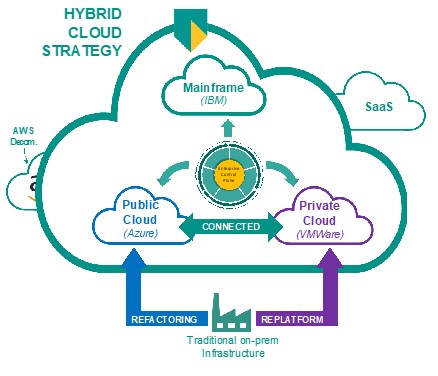In turbulent economic times, people and businesses turn to banks for support. But many institutions struggle to deal with rapidly changing customer expectations whilst keeping up with the latest technology. ABN AMRO is on a journey to leave legacy technology behind and become a more personal bank in the digital age.
ABN AMRO is a Dutch bank with a vision of a more inclusive, sustainable, and customer-centric future. It is committed to playing a profound role in society and providing “banking for better” for generations to come. To realize its goal of becoming a personal bank in the digital age, ABN AMRO needs to get new services—such as virtual appointments over video chat—to market quickly. But with a complex legacy technology environment, that is easier said than done.
“The role of banks changes during uncertain times. Our customers are looking for value-based services, which means a shift away from providing credit and savings accounts to self-service apps and personalized support,” says Jan van Groningen, chief technology officer at ABN AMRO.
To speed up time to market, ABN AMRO embarked on a journey to agile methodologies, DevOps, and the public cloud to get there in three to four years.
“Having clear goals to guide your IT transformation is key, but so is being flexible on how you get there,” van Groningen explains. “Our ultimate goal was to provide end-to-end tech stacks with everything the business and application teams need to develop at speed. We soon realized migrating solely to the public cloud did not always have the velocity and did not offer the autonomy required. So, we redefined our platform and placement strategy.”
The team settled on a hybrid cloud approach and analyzed its existing environment to identify legacy technology not offering value. This included in-sourcing its managed private cloud to get greater control over its own environment and break free of the constraints of a costly, rigid agreement. The bank also decided to keep positioning its mainframe as a strategic platform, use Microsoft Azure Cloud as its primary public cloud platform, decommission its AWS-platform, and build a private cloud with VMware Cloud Foundation™.
Re-platforming on hybrid cloud
ABN AMRO kicked off a complete platform modernization. With VMware Cloud Foundation, ABN AMRO has integrated cloud management capabilities across its hybrid cloud platform spanning private and public environments. The bank now has the freedom to run applications anywhere without the complexity of application re-writing. ABN AMRO migrated almost half of its applications to the Microsoft Azure Cloud. This included completing the technical cloud migration and creating teams responsible for managing infrastructure. In addition to migrating the applications to the cloud, this also involved adopting the DevOps way of working and undergoing a transformation. To decide which applications and workloads to move, it used a value-based approach.
“Our strategy comes down to hosting the right application on the right platform,” says Maarten Spit, head of design and engineering at ABN AMRO. “We assess potential re-platforming on its added business value. For instance: will refactoring the application eventually increase Net Promoter Score (NPS), increase revenue, or decrease operational costs? And to what extent does the application monetize typical cloud capabilities. There is no single answer to this. We have thousands of different applications, ranging from core enterprise applications to microservices-based components supporting our digital journeys. It requires a balanced strategy to find the right platform for each one of them.”
If an app was hosted on AWS, it would be a good candidate to move to Microsoft Azure or VMware Cloud Foundation. However, high-performance apps running in the mainframe environm¬ent benefited from the low latency between the bank’s two data centers, so these are not re-platformed to the cloud.
When ABN AMRO migrated half of its workloads to its Microsoft Azure platform, the bank reflected on the lessons learned and refined its strategic course. “Our platform strategy changed into a hybrid strategy, leveraging the best of both worlds (on-prem and off-prem) with a central catalog” explains Spit. “Our hybrid platforms are the cornerstone for many innovations offered to our clients. Harmonizing them is key.”

ABN AMRO launched a campaign to foster greater collaboration, centralizing on one control plane to eliminate competition between internal teams who were using two different solutions. This unified product catalog harmonizes working practices and makes the team more efficient. But the bank also needed to change how it worked with third-party vendors.
“Managed services and DevOps had a bad relationship. It was like a black box with a contract in the middle, which hindered agility,” says van Groningen. “We reintroduced private cloud to replace our managed service agreement with IBM and made capacity-based agreements.”
The bank took best practices and capabilities from strategic partners and embedded them into its operating model. It then put capacity-based agreements in place to allocate responsibilities to dedicated teams or vendors, which placed greater accountability on the individual.
“We harmonized our platforms and aligned our people. Everyone now uses the same tools and platforms,” says van Groningen. “That unlocks greater efficiency and velocity.”
Accelerating time to market
Developers enjoy features such as automation, a product catalog, comprehensive documentation, test tooling, and sandboxes, which all help deliver new applications and services quickly. The company also expanded its API-first strategy, adopted five years previously, for external developers working on open-banking applications.
“We’re taking back ownership of our technology. Managing that cultural shift was important to get everyone on the same page. We’re in a strong position to continue our platform transformation and deliver better services to customers at speed,” Spit says.
Embarking on a large-scale project takes courage. ABN AMRO took that to the next level by identifying when it needed to adjust expectations and take more time to execute its strategy. As a result, the bank has aligned its team around shared goals. And that makes for a great foundation to embrace the future of digital banking and respond quickly to the changing needs of customers.

